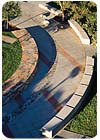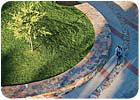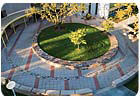
Recently, a plaza outside the Segundo Dining Commons on the campus of the University of California at Davis was constructed with stone architecture - creating an inviting atmosphere where students can eat, relax and socialize. Inspiration for the form of the plaza came from the dining hall's strong circular entry wall.
With several thousand students passing daily through the plaza at the entrance to the Segundo Dining Commons on the campus of the University of California at Davis, school officials desired to create an environment that would facilitate social interaction. Keeping this objective in mind, a landscape architect from Sasaki Associates of San Francisco developed an inviting space where students can sit, eat, talk or study. And at the heart of the design is a warm palette of stone varieties, which bring vibrancy and depth to the outdoor area.

Primarily, the plaza is comprised of a large circular stone wall featuring four different types of stone - Three Rivers, Early Sunset, Gold Quartzite and Sedona Lead Stone - which were all supplied by SVI of Windsor, CA.
“We wanted to use this outdoor space as an opportunity to engage students,†said Landscape Architect Jim Jacobs of Sasaki Associates. “Inspiration for the strong circular form of the plaza was driven by the desire to welcome visitors coming from the north, west and east. The circle also engages the strong, curving entry wall of the dining commons.

The stone varieties chosen for the massive stone wall and decorative paving band reflect the rich earth tones found in California's Central Valley.
But in the end, stone cladding was replaced with stucco for the exterior facade. “We still saw it as an opportunity to enhance the outdoor environment for pedestrians with stone materials, and relate the forms and colors to the tilework in the interior spaces,†said the landscape architect. “[The building] serves as the main dining hall for the Segundo precinct of campus, which houses the freshmen and serves three meals a day. Our emphasis was to use stone on the big elliptical wall because it is the centerpiece in the landscape - ranging from 3 to 5 feet wide at the top. We wanted to create a place where students can bring meals out, lay out, sit with their laptops and socialize.â€
The shades of stone that were chosen reflect the colors found in California's Central Valley, according to Jacobs. “I didn't want it to look monolithic,†he said. “I wanted to create a rich complexity in colors. They are primarily warm earth tones. The vibrant red of the Sedona flagstone complements the subtle tones of the exterior facade.â€

“It resembles a gem necklace, strung together to connect the building columns with the plaza,†said Landscape Architect Jim Jacobs of Sasaki Associates, when speaking about the decorative band that accents the colored concrete paving. Pieces of glass tile were also added to the band, giving it a bit of a sparkling effect.
The same stones that were used to build the large elliptical wall were also utilized to create the decorative circular band in the paving. “It resembles a gem necklace, strung together to connect the building columns with the plaza,†said the landscape architect, adding that some glass tile was also embedded in the band. “The main entry of the building is treated with mosaic glass tile around the door. We didn't use the same tile, but picked up on the motif for the decorative band. It adds a nice sparkle to the horizontal surface.â€
Forming the stone architecture
According to Jacobs, a mock-up was done for the wall as well as the decorative paving band. “Our specifications called for mock-ups,†he said. “When we went out to inspect them, they didn't look like what we wanted. [The stonemason] laid them out again on site, and we made comments such as getting tighter joints and mixing up the colors better.“We worked with photographs because of the tight time constraint,†the landscape architect continued. “The contractor would take photos and send us the pictures, and we would look at them quickly and respond. The second time around, the contractor really did a nice job of picking up our comments and making it happen.â€

The overall construction process took about two years for the entire project, including building and site work. The stone wall was built in about a two-week period.
“Everyone is very happy,†said the landscape architect. “The materials and colors are working out very well. The plaza and dining hall are quite popular on campus.â€
Outdoor Plaza
Dining Common
University of California at Davis
Architect and Landscape Architect: Sasaki Associates, San Francisco, CA
General Contractor: Howard S. Wright
Stone Supplier: SVI, Windsor, CA
Stone Mason: Gentry Masonry Construction, Santa Rosa, CA
